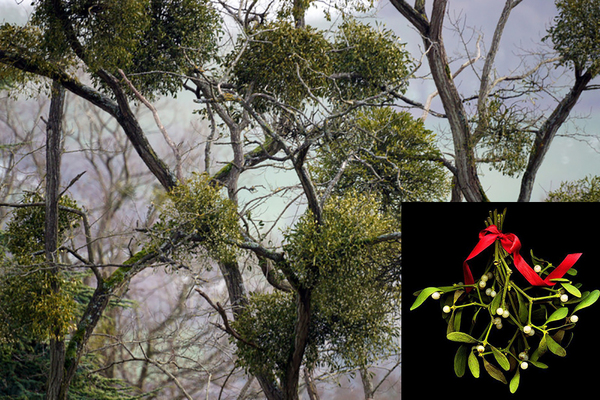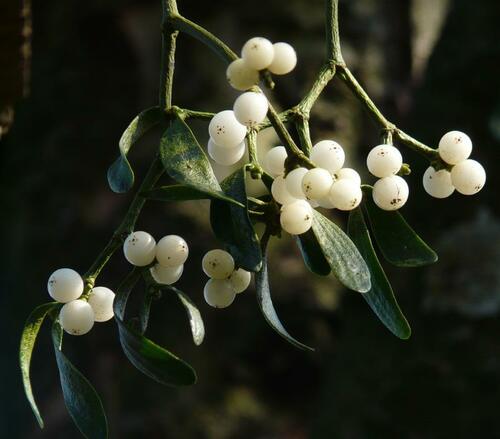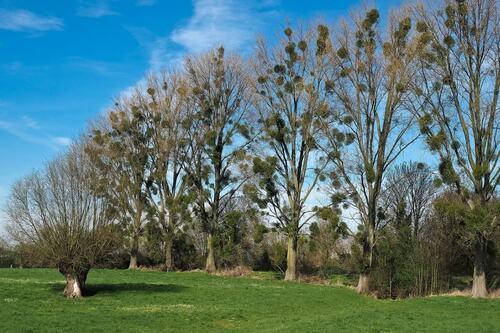Mistletoe Facts: Understanding its Impact on Trees and Wildlife

Photo Credit: TMV Media, Flickr
Mistletoe Facts
First, the data. Mistletoe is the common name for a parasitic plant with yellowish flowers and glutinous white berries that grow attached to, and within, the vascular system of a tree or shrub.
Mistletoe does not normally kill a tree, but it can be a contributing factor in the loss of a tree if the tree has other problems. Mistletoe stays green in the winter when its host tree goes dormant. The deciduous trees are nearly all bare then, putting their branches—and whatever is living in them—in full view. If you think you see a bird’s nest, look a little closer, and you might discover that your tree is playing host to a growth of mistletoe.
Mistletoe is an enigma—it is one of the most curious and magical plants, uninvited but captivating, and it is discerning about its host—it loves poplars, apples, hawthorns, and willows and appears on a small selection of other species, but it is extremely rare for it to grow on oak.
A Unique, Beneficial Species

A Close-Up of Mistletoe Berries - Image by Hans from Pixabay
Not all mistletoe carries berries. It is dioecious, which means the male plants are separate from the female ones and only the latter have berries. This explains why a very healthy ball can be entirely without berries, whereas another nearby can be much smaller but bedecked with them.
Many biologists consider mistletoe to be a fundamental species that affords surprising benefits to a list of forest inhabitants. Studies have revealed that removing large amounts of mistletoe results in a lower local bird population, as they often use it for nesting. Furthermore, because mistletoe lives off of trees, its leaves are chock-full of nutrients. When its leaves fall, they enrich the soil and benefit ground-dwelling species.
Mistletoe Trivia

Clusters of Mistletoe Grow on a Row of Trees
While doing research on mistletoe—a topic perfect for the week before Christmas—we found an entertaining source with several very interesting and amusing facts about mistletoe. Take time to visit to their site if you love trivia and very useful “useless" information.
- Worldwide, 1,300 mistletoe species exist, with 30 in the US and Canada.
- The mistletoe’s white berries are toxic to humans but provide high-protein food during autumn and winter for mammals and many bird species. Birds also rely on mistletoe for nesting material. Butterflies lay their eggs on the plants and use the nectar as food. Mistletoe is also an important pollen and nectar plant for bees.
- Despite its parasitic tendencies, mistletoe has been a natural part of healthy forest ecosystems for millions of years.
- All mistletoes grow as parasites on the branches of trees and shrubs. The genus name of North America’s oak mistletoe—by far the most common species in the eastern United States—is Phoradendron, Greek for “tree thief."
- The growth of mistletoe has little to do with the bird droppings and a lot to do with the birds themselves. Mistletoe seeds are extremely sticky and often latch onto birds’ beaks or feathers or the fur of other woodland creatures, hitchhiking to a likely host tree before dropping off and starting to germinate.
- The dwarf mistletoe doesn’t have to rely solely on hitchhiking to find a host tree. The ripe white berries of dwarf mistletoe, native to the western United States and Canada, can also explode, ejecting seeds at an initial average speed of 60 miles per hour and scattering them as far as 50 feet.
- Ancient Anglo-Saxons noticed that mistletoe often grows where birds leave droppings, which is how mistletoe got its name: In Anglo-Saxon, mistel means “dung," and tan means “twig," hence, “dung on a twig."
- Trees infested with mistletoe die early because of the parasitic growth, producing dead trees useful to nesting birds and mammals. A mistletoe-infested forest may produce three times more cavity-nesting birds than a forest lacking mistletoe.
- As they mature, mistletoes grow into thick, often rounded masses of branches and stems until they look like baskets, sometimes called “witches’ brooms," which can reach 5 feet wide and weigh 50 pounds.
- When a mistletoe seed lands on a suitable host, it sends out roots that penetrate the tree and draw on its nutrients and water. Mistletoes also can produce energy through photosynthesis in their green leaves.
- Kissing under the mistletoe was first found to be associated with the Greek festival of Saturnalia and later with primitive marriage rites.
- In Scandinavia, mistletoe was considered a plant of peace under which enemies could declare a truce or warring spouses could kiss and make up.
- The eighteenth-century English are credited with a certain magical event called a kissing ball. At Christmastime, a young lady standing under a ball of mistletoe brightly trimmed with evergreens, ribbons, and ornaments, could not refuse to be kissed. Such a kiss could mean deep romance or lasting friendship and goodwill. After each kiss, a berry was picked until, alas, all the berries were gone, and no more kissing was allowed! If the girl was not kissed, she could not expect not to marry the following year.
Use Caution When Bringing Mistletoe Indoors

Mistletoe Hangs Over a Doorway - Photo by Paul Zoetemeijer on Unsplash
If you are thinking about using mistletoe indoors for the holidays, be careful. Mistletoes are poisonous, especially the white berries. Though mistletoe is less threatening to adults, pets and children may be more sensitive to the berries. Be sure to keep your mistletoe well out of their reach.
If you want a big kiss or if you are a naturalist, mistletoe is a treasure. If a tree's health or structural integrity is a concern, it’s a parasite.
So, is mistletoe friend or foe?
In actuality, it is both. It’s magical, and with proper management, its drawbacks can be controlled. Moderation is the key.
Enjoy the Christmas season and make wonderful plans for an exciting New Year—in moderation, of course! And make a resolution to contact Arborist Now for all of your tree care needs.
Originally Published on December 19, 2016.





